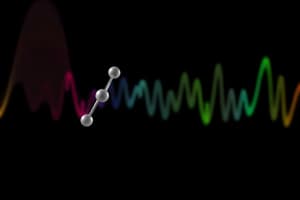Podcast
Questions and Answers
What role does spin play in the behavior of nucleons in NMR spectroscopy?
What role does spin play in the behavior of nucleons in NMR spectroscopy?
Spin creates a magnetic moment in nucleons, allowing them to align with or against an applied magnetic field.
How does NMR spectroscopy differ from IR spectroscopy in terms of the radiation used?
How does NMR spectroscopy differ from IR spectroscopy in terms of the radiation used?
NMR spectroscopy uses radio waves to detect molecular structures, while IR spectroscopy employs absorbed infrared radiation.
Describe the energy states of protons when subjected to a magnetic field in NMR spectroscopy.
Describe the energy states of protons when subjected to a magnetic field in NMR spectroscopy.
Protons can be in a lower energy state when aligned with the magnetic field, or a higher energy state when aligned against it.
What happens to protons after the radio frequency pulse is removed in an NMR experiment?
What happens to protons after the radio frequency pulse is removed in an NMR experiment?
Explain the significance of the equation E = h · v in the context of NMR spectroscopy.
Explain the significance of the equation E = h · v in the context of NMR spectroscopy.
Flashcards are hidden until you start studying
Study Notes
Introduction to NMR Spectroscopy
- NMR (Nuclear Magnetic Resonance) spectroscopy is an analytical technique used for identifying molecular structures.
- Unlike IR (Infrared) spectroscopy, which detects bonds via absorbed infrared radiation, NMR employs radio waves.
Properties of Nucleons
- Nucleons (protons and neutrons) possess a "spin" property, generating a magnetic moment.
- Protons in the absence of a magnetic field spin in random directions.
Magnetic Field Application
- When a strong magnetic field is applied, protons can either align with or against the field.
- Two energy states are established:
- Lower Energy State: Protons aligned with the field, indicating stability.
- Higher Energy State: Protons aligned against the field, indicating instability.
Energy Transition
- Application of radio frequency pulses to nucleons allows them to absorb energy and transition to the higher energy state.
- This energy absorption is explained by the equation (E = h \cdot v), where:
- (E) is the energy difference ((\Delta E)) between the two states.
- (h) is Planck's constant.
- (v) is the frequency of the radiation.
Relaxation and Signal Detection
- Once the radio frequency pulse is removed, protons cannot remain in the higher energy state due to instability and return to the lower energy state.
- During this relaxation process, protons emit radio frequency pulses detected by the NMR apparatus, providing data on the molecular structure.
Introduction to NMR Spectroscopy
- NMR spectroscopy analyzes molecular structures through the behavior of atomic nuclei in a magnetic field.
- Utilizes radio waves, contrasting with infrared spectroscopy that employs absorbed infrared radiation to detect molecular bonding.
Properties of Nucleons
- Nucleons, which include protons and neutrons, have a fundamental property known as "spin," leading to the creation of a magnetic moment.
- In the absence of a magnetic field, protons exhibit random spinning directions that do not align.
Magnetic Field Application
- A strong magnetic field influences protons to align either in the direction of the field or against it.
- Establishes two distinct energy states:
- Lower Energy State: Protons aligned with the magnetic field, representing a more stable configuration.
- Higher Energy State: Protons aligned against the magnetic field, indicating a less stable configuration.
Energy Transition
- Radio frequency pulses deliver energy to nucleons, which enables them to transition to the higher energy state.
- The energy difference between the two states is defined by the equation (E = h \cdot v):
- (E) represents the energy difference ((\Delta E)).
- (h) symbolizes Planck's constant.
- (v) denotes the frequency of the applied radiation.
Relaxation and Signal Detection
- Upon removal of the radio frequency pulse, protons revert to the lower energy state because of inherent instability in the higher state.
- During this relaxation, protons emit their absorbed energy as radio frequency pulses, which are captured by the NMR instrument to reveal valuable information about the molecular structure.
Studying That Suits You
Use AI to generate personalized quizzes and flashcards to suit your learning preferences.



